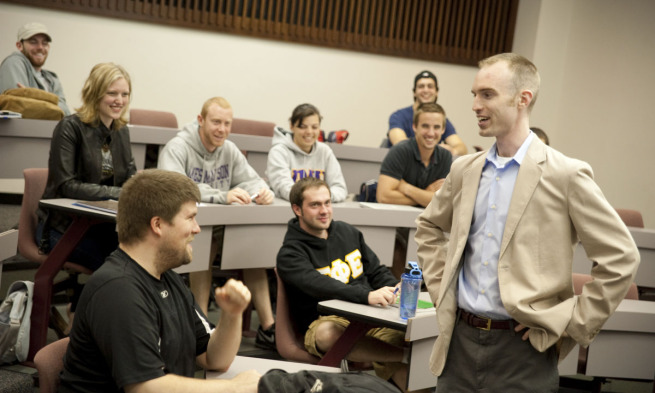Jumping off a cliff
Business
… and assembling your plane on the way down
The illustration might seem absurd, but it conveys the entrepreneurial experience quite well according to Bill Wales, assistant professor of entrepreneurship at JMU. "You either make it, or you don't," he says.
It's all about problem solving
At its core, entrepreneurship is about problem solving. Having identified a problem, the entrepreneur goes into action mode. "You have to come up with a solution and put it out there. Sometimes it works; sometimes it doesn't. You don't really know until you observe the solution that you have," Wales says.
The professor has definitely solved the problem of how to effectively teach the basics of the rough and tumble experience of entrepreneurship.
Wales began his JMU career in 2009. "I came to JMU because it's a balanced school. It emphasizes and rewards both research and teaching," he says. He wanted hands-on experience to be a large part of his teaching the MGT 372 Entrepreneurship course. In Wales' classes there are no tests, at least not the typical kind. "The test is getting out there and learning from experience," he says.
Learn by doing
And he gets his students out there in a hurry. Spending a great deal of time in business planning early in the process often sets entrepreneurs up for failure, not success. Wales explains the irony, "People tend to focus their activity and mindset on planning rather than doing. What the entrepreneur needs to be doing is going out there and working with their product." Sound scary? Like trying to build your plane before you hit the pavement?
Not to worry. Wales' tactic works quite well. "I use a portfolio approach in the course," he says. "Students can start as many ventures as they want. It's a valuable way to unleash creativity." Rather than spending time on trying to mitigate all the risks of their ventures before they get started, Wales' method allows students to try and fail. "They get started earlier and are willing to embrace their failures and learn from them," he says. His students quickly redirect their attention to doing it better.
Embrace failures, find success
For instance, Ashley Kehoe ('10) and her team couldn't get the consistency right for the sugar-wax hair removal product they were working on. Solving a problem closer to personal interests moved them from failure to success. Kehoe, an event rider, realized that their sticky concoction was the perfect consistency to adhere to a horse's foot. With therapeutic additions of Epsom Salts and Betadine their sticky sugar product could be an excellent soreness relieving hoof pack for horses with footsoreness. Rebound Hoof Pack was born.
Trial and error is fundamental to entrepreneurship, and Wales is adept at instilling the entrepreneurial mind-set into his students. "I always ask them, 'What's the quickest, fastest, cheapest way you can test your product or service?'" he says. "If it works, then you put extra time into it. Why put a lot of time into something that isn't working?'
Coming up with a great idea is not always the hard part of entrepreneurship. Ski enthusiasts Kyle Houser ('10) and members of his iGroup team realized there was a market for a low-cost, do-it-yourself solution for protecting the consumer's investment in expensive sports equipment. Then the real challenge began. Repeated experiments, failures and formula adjustments finally led to Cool Wax, a ski and snowboard protectant wax applied over metal edges to prevent rust and deterioration. "That's the entrepreneurial process, figuring out how you can solve a problem in the market, and then how you can solve the problems that arise as you develop the product," says Houser.
Wales acts as a small business coach for his students. One of his favorite techniques is to ask them questions and guide them to the answer. It's the reverse of the traditional teaching method of pushing information to students. "I found that students learn significantly more when they are pulling the information," Wales says.
"In many entrepreneurship courses, you have a grandiose business plan at the end, but it is not based in reality," says Wales. "The businesses are dead before they take off. In this class, I have found that if students have created a venture that has taken off, they will continue it past the class end."
Indeed they do.
Kehoe has taken Rebound on the road, or more specifically, to horse shows and competitions. Rebound is now endorsed by Karen O'Connor, four-time U.S. Olympic Eventer, several other members of the U.S. Olympic team, and one member of the Canadian Eventing team; and the list is growing. Cool Wax has not only been successful at the local ski resorts of Bryce and Massanutten, it has sold out in Lake Tahoe, and in Utah and Colorado ski resorts. "We'll take it as far as we can," says Houser.
Creating value
However, thriving new ventures are not the only measure of successful entrepreneurs. "Most entrepreneurs find other means of collecting upon their ability to solve problems," says Wales. "No matter what you are doing, your goal is to be creating value. The creation of value occurs when you are able to solve a problem that's important to people, better than currently available solutions," he says. "No matter where you are, your ability to create value is going to define you as a manager of a corporation, as an entrepreneur, as a member of society."
Students clearly realize the reward they've gained from completing the course. Josh Shull ('10) says, "I learned to try quickly, fail fast and move on even faster than you failed. You can be an entrepreneur; you can also be an intrapreneur, solving problems within companies."
That's just the conclusion Wales wants his students to come to — the firm conviction, "I can solve problems." After all, business is based on solving problems.
And so is much of life itself.
